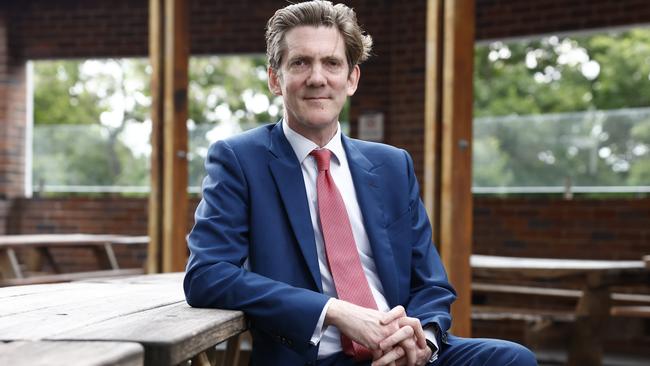
However the central bank appears to have lowered its estimate of the so-called “neutral” cash rate, suggesting monetary policy is tighter than previously thought.
The labour market beat expectations for the third month in a row in January, adding 54,100 jobs versus 20,000 expected. But the unemployment rate still rose from 4.0 per cent to 4.1 per cent as the labour force participation rate hit a record high of 67.3 per cent.
Speaking on Bloomberg TV, RBA deputy governor Andrew Hauser said the data showed the labour market was “incredibly strong”, but “inflation has come down as well”.
“We still need a bit more good news on inflation coming back to that midpoint,” he added.
Dr Hauser said if the RBA didn’t cut rates in February, inflation would have “undershot.”
One of the pieces of information that the board reviewed before making its decision was an alternative version of that forecast which looked at what would happen if we held interest rates constant.
“Under that forecast inflation didn’t stop at 2.7 per cent, it undershot the midpoint. Not by a lot but by a little bit and that factor alone was quite an important input into the board’s decision.”
In its monetary policy decision statement on Tuesday, the RBA board said it had “more confidence” that inflation was moving sustainably toward the midpoint of its 2-3 per cent target band after underlying inflation fell more than expected, private demand was weak and wage pressures eased.
“However, upside risks remain,” the board said. “Some recent labour market data have been unexpectedly strong, suggesting that the labour market may be somewhat tighter than previously thought.”
In its statement on monetary policy, the bank trimmed its underlying inflation forecast to 2.7 per cent for mid-2025. However, it also forecast that if the bank were to cut the cash rate to 3.4 per cent by mid-2026 as the money market implied, underlying inflation would stay at 2.7 per cent through mid-2026, thereby overshooting the midpoint of its target band for at least 16 months.
RBC Capital Markets chief economist Su-Lin Ong said there’s no denying the underlying strength of this labour market, although so-called non-market jobs - particularly healthcare and social assistance were likely to be part of the explanation, underpinned by the NDIS and structural change.
With December quarter wage price index data this week confirming a moderation in wages growth consistent with signals from other wage and labour- cost metrics, there was intensifying debate over whether the economy and labour market can grow faster yet be consistent with the inflation target.
This would imply that the so-called non-accelerating inflation rate of unemployment is lower than the RBA’s most recent model estimates of 4.5 per cent. But the RBA has forecast an unemployment rate of 4.2 per cent from mid-2025 through mid-2026, implying that inflation may pick up.
“The RBA may be open to the idea of a lower NAIRU - not just the unemployment rate but a broader suite of labour market indicators -, but it will to need to see further evidence of ongoing labour market strength, moderating unit labour costs and lower price/inflation data,” Ms Ong said.
“This underscores a likely patient and careful approach to monetary policy in 2025 with further easing likely, but it will be modest and likely drawn out.”
Meanwhile CBA’s head of Australian economics Gareth Aird said the RBA looks to have revised down its estimate of the so-called “neutral” cash rate in Tuesday’s Statement on Monetary Policy.
The average of seven models used by the RBA to estimate the nominal neutral rate was 2.9 per cent.
“Such an outcome is materially below the RBA’s previous point estimate of the nominal neutral cash rate of about 3.5 per cent,” Mr Aird said. “The downward assessment of the neutral cash rate more closely aligns to our thinking on where the neutral cash rate sits.”
“The RBA Board should feel more confident to ease policy through 2025 based on its re-assessment that the neutral cash rate is lower than it previously assumed.”
He said this updated view “flew under the radar” given so much of the commentary following the Board’s decision to cut the cash rate by 25bp to 4.1 per cent was on the decision itself.
“Given the RBA has lowered its implicit estimate of the neutral cash rate to about 2.9 per cent, the underpinning cash rate assumption in the February SMP implies monetary policy remains restrictive over the forecast horizon,” he said.
This should have led to a lower forecast for trimmed mean CPI over the forecast horizon, as a lower neutral rate assumption implies the current cash rate level is more restrictive on private sector activity in the economy. But there were very little changes to the RBA’s overall GDP forecasts.
“It appears stronger than anticipated public demand is offsetting weaker expected private demand growth, particularly a softer household consumption outlook,” Mr Aird added.
“Put simply, the RBA views the stance of fiscal policy a slightly more stimulatory than previously assumed. From the RBA’s perspective, this offsets the now lower estimate of the neutral cash rate.”
“If the neutral rate is indeed closer to 3 per cent, monetary policy could be further eased in 2026.
“However, the stance of fiscal policy will have a big bearing on where the cash rate finally settles.”






Australia’s strong labour market remains an upside risk to the inflation outlook that may limit the amount of interest rate cuts the Reserve Bank can deliver this year, economists say.